Erosion: Essays of Undoing
Air Date: Week of April 10, 2020

Castle Valley, the home of Terry Tempest Williams. (Photo: courtesy of Terry Tempest Williams)
Writer Terry Tempest Williams’ latest book, “Erosion: Essays of Undoing”, grapples with the erosion of democracy, science, compassion, and trust, as her beloved Utah red rock landscape faces oil and gas extraction, and the planet faces destructive warming. At a Good Reads on Earth live event, Williams spoke with Host Steve Curwood about how science and Native knowledge alike can guide us on a more sustainable path, and why erosion also creates an opportunity for evolution towards a better future.
Transcript
CURWOOD: It’s Living on Earth, I’m Steve Curwood.
In these times it may seem the whole world is eroding before our eyes. But grappling with profound loss, uncertainty, and change is nothing new for writer Terry Tempest Williams. Her 1991 memoir Refuge: An Unnatural History of Family and Place, set her searing exploration of grief and courage in the arms of nature. Now almost thirty years later Terry has written, Erosion: Essays of Undoing that mourn the erasure of public lands as well as personal losses. As a Writer-in-Residence at the Harvard Divinity School, Terry Tempest Williams divides her time between Cambridge, Massachusetts and Castle Valley, Utah, nearly a mile above sea level on the Colorado Plateau. She joined us at a Good Reads on Earth live event in Cambridge, thankfully before physical distancing made such gatherings impossible.
[APPLAUSE]
CURWOOD: So let's start at Castle Valley, Utah, a place that is so essential to this book. Paint a picture for us, would you, of how it's been shaped by the forces of erosion over these millions of years?
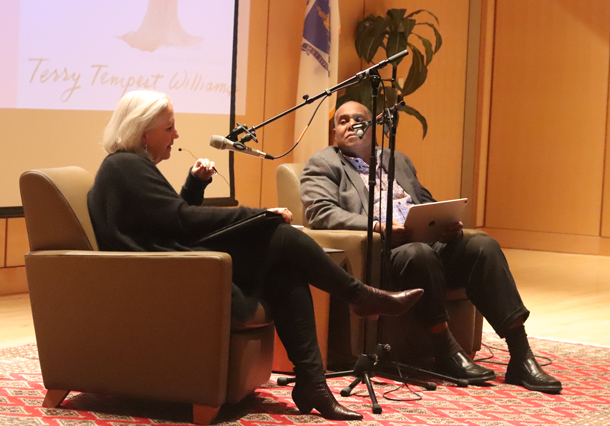
Terry and Living on Earth Host Steve Curwood at the “Good Reads on Earth” live event in Cambridge, Massachusetts, in January 2020. (Photo: Jay Feinstein for LOE)
WILLIAMS: Steve, if you and I were having this conversation on our porch, facing south you would see Round Mountain, which is a volcanic plug. It looks like a breast. If you were to see beyond Round Mountain, you would see the La Sals, rising almost 14,000 feet. To the west, is Porcupine Rim. To the north is the Colorado River running red. And to the east with the rising sun is Castleton Tower and a red rock sandstone formation called The Priest and Nuns, created out of erosion. It is a still place; my measure of quiet is to be able to hear the wingbeats of ravens, which we do. And in the spring, certainly the, the songs of the meadowlarks, and at night, coyotes. So it's a wild place. It's also a domesticated place. It's a community of about 250 people, as diverse as you can imagine; but we are known in Moab, Utah, about an hour from us, as the People's Republic of Castle Valley.
CURWOOD: [LAUGHS]
WILLIAMS: And so it's an unpredictable place.
CURWOOD: So, the red rocks are so seductive, aren't they? It's just amazing. Pictures, though, are tough on radio, but I understand you've brought some sound for us, right? It's a sound of the Earth that you can share with us, straight from the desert. Please tell us about what we're about to hear now.
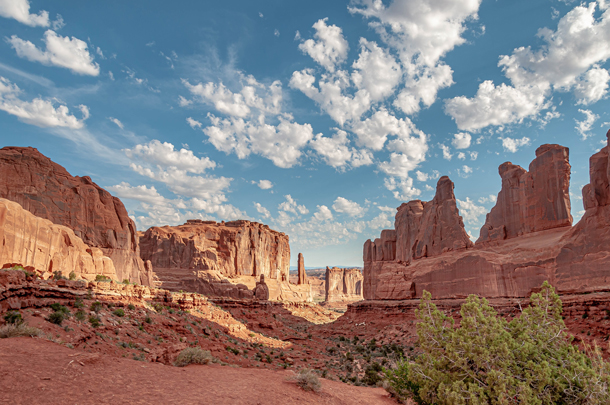
Formations in Arches National Park. Utah’s red rock landscape has been whittled into fantastical shapes over the course of millions of years of weathering and erosion. (Photo: Stephen Walker on Unsplash)
WILLIAMS: Last fall, Jeff Moore, a geologist from the University of Utah, with four graduate students. They've been doing work looking at the porosity of these landforms: buttes, mesas, in particular, arches, hoodoos in the Valley of Gods, and spires. What is their lifespan? What is the process of erosion? How strong are they? They came to Castle Valley, they brought their seismometers; it would be like a stethoscope. They enlisted two climbers, and they put one seismometer at the base of Castleton Tower. Imagine that it is a 400-foot, Wingate Sandstone monolith, one of the largest freestanding spires in the world. The climbers went up that 400 feet, placed a second seismometer on top, and Jeff Moore and his graduate students listened. What they heard, surprised them. Castleton Tower has a pulse.
[SOUND OF CASTLETON TOWER VIBRATIONS]
And it amplifies the energy that flows through them. It can be local: helicopter, traffic, climbers, wind. It can be planetary: the waves of magma, the waves of the Pacific Ocean, earthquake. So with their permission I brought a recording, and see if you can hear the pulse. It's a vibration. It's a resonance. But as you listen, it mirrors our own heartbeat.
[SOUND OF CASTLETON TOWER VIBRATIONS]
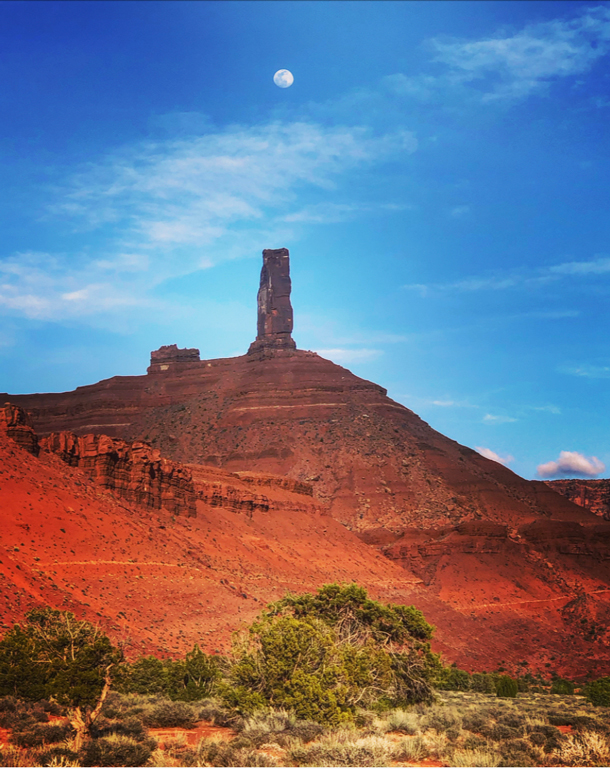
The Castleton Tower red rock formation, near Terry Tempest Williams’ home in Castle Valley, Utah. (Photo: courtesy of Terry Tempest Williams)
Castleton Tower has a pulse. We have a pulse. The earth has a pulse. We took that to Jonah Yellowman, who is the Spiritual Advisor for the Bears Ears Coalition, with Utah Diné Bikéyah, Steve, and I'll never forget him holding that to his ear and just nodding, for three or four minutes. And then he said, "This is what we know." And I think about Western science, geologists; what scientists know, and what native people know. And that we're at this point where those knowledges, those wisdoms, the facts, and the feelings are merging together in a common language. And I think if we could realize that Castleton Tower has a pulse; Bears Ears have a pulse; the ocean, the Atlantic right here, just outside Cambridge has a pulse. Would we treat the earth differently? Would we see ourselves in relationship to the natural world differently?
CURWOOD: I understand you have a passage from your new book, "Erosion: Essays of Undoing" that you'd like to read, Terry; please set this up a bit for us, comes from the very end, I think.
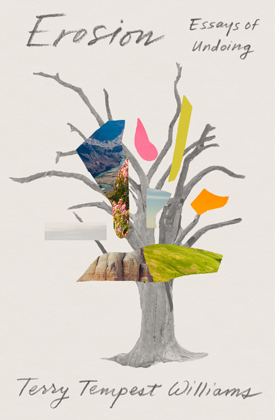
“Erosion: Essays of Undoing” follows in the spirit of other books by Terry Tempest Williams, including “When Women Were Birds: Fifty-four Variations on Voice” (2012), and the environmental classic “Refuge: An Unnatural History of Family and Place” (1991). (Image: Courtesy of Sarah Crichton Books)
WILLIAMS: You know, what is erosion? It's a natural process. A scientific definition would be the surface of the Earth, worn down and moved from one place to another, through the force of gravity, and I think movement is the key with erosion. It's different than just weathering in place, of wind, water and time. I have to say, I met a geologist named JoAnn Holloway, who works for the USGS, the United States Geological Survey, and she came up with her own definition, which is "the inevitable process by which rock seeks the ocean." Don't you love that? And then a literary definition: "All souls come here to rub the sharp edges off each other. . . . This isn't suffering, it is erosion." Chuck Palahniuk of Fight Club. So this is the end of the book actually. [READING FROM "EROSION"] "Early in our evolution, we discovered as Homo sapiens through need and necessity that our imaginations can summon power. Fire became a dream ignited that enabled us to feed ourselves and gather round to share stories. Stories are power. Power resides in community. When power is denied and oppresses others, we can resist, and when we resist together, something else can occur, something new emerges. This is the essence of erosion and evolution in human time. In geologic time, transformation can be slow and corrosive, or catastrophic and quick. It may be a cataclysmic moment or it may happen incrementally over time. Deep change requires both. And it is not without its ruptures. It can be associated with devastation or determination. It can also be beautiful. Weathering agents are among us. This is a time of exposure. I dwell in Utah. I am witnessing change. Wind does wear down stone." I think it's that idea, Steve, that we are both evolving and eroding together. Wind does wear down stone. We can resist, we can insist change, together.
CURWOOD: Now a central piece of your theme of erosion in this book is the shrinking of national monuments that the Trump administration undertook at Bears Ears. Now, granted, President Obama waited till the last second in his administration, really, to set aside Bears Ears. But when President Trump came in, the Bears Ears designation shrunk by 85% of its original area. Why did these dramatic changes to these designations affect you so, so deeply? And paint a picture in our minds of what we would see if we were there and of course, the iconic piece that everyone calls Bears Ears.
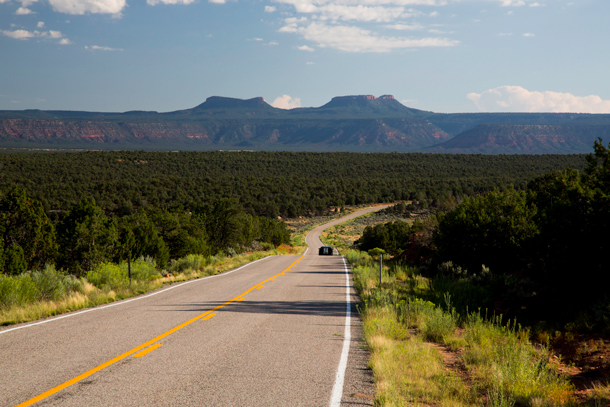
Bears Ears National Monument has been reduced by 85% of its original designation. (Photo: Bob Wick, BLM, Flickr CC BY 2.0)
WILLIAMS: Bears Ears are two buttes, and they look like bears' ears. They're covered with piñons. They are in the middle of what we refer to as Grand Gulch. It's just outside of Blanding, Utah, very near the Four Corners region, where Utah, Colorado, New Mexico and Arizona share a common boundary point. They can also be seen from Monument Valley. They're powerful. I've known them as a child, but I didn't know their history until really, relatively recently. The Diné, Navajo, Hopi, Zuni, Ute Mountain Ute, Ouray Ute, many of the Pueblo people. These are sacred lands. Bears Ears is a gathering place for many, many nations. And as Johan Yellowman would say, they're not just protecting Bears Ears for their people, but for all people. President Obama heard their cries, as did Secretary Jewell. It was a handshake across history. It was new trust. And it was this commitment that traditional knowledge would be married with Western science in protecting these very fragile desert lands. Trump came in and gutted it by 85%. And now it's open for business. Uranium mining, oil and gas leases, coal; and Bears Ears isn't the only one affected, and I want to read you the list. Chaco Canyon. Hovenweep. Mesa Verde. Theodore Roosevelt National Park. Canyonlands National Park. Great Sand Dunes. Rocky Mountain National Park. Big Cypress. Grand Teton National Park. Carlsbad Caverns. Dinosaur National Monument. Sequoia National Park. All of these national parks and monuments are being affected by oil and gas leasing, in the parks and outside the parks. This is, 25% of the greenhouse emissions are excavated out of our public lands. If we were to halt oil and gas leases on our public lands, that belong to all of us, and we have to keep in mind before they were public lands, they were native lands, we would stop 450 million tons of climate pollution.
CURWOOD: You point out that there's all this carbon, gets spewed into the atmosphere from the excavation and drilling and extraction from public lands. And tell me about, back in 2016 when you and your husband Brooke decided to take a unique stand against the erosion of public lands and the leasing of public lands for oil and gas development, by purchasing the leasing rights to, what, more than 1100 acres near your home there in Utah, to be developed by the Tempest Exploration Company, LLC. Not for fossil fuels, but apparently for the energy that will fuel the moral imagination, you wrote. What inspired you to do this?
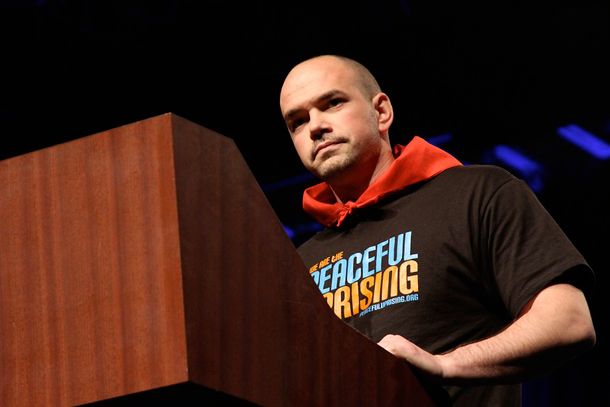
Tim DeChristopher, also known among climate activists as “Bidder #70”, served nearly 2 years in prison for bidding up oil and gas leases on 22,500 acres of public land in Utah’s redrock country, with no intent to pay for them. “Erosion” features a transcribed conversation between DeChristopher and Terry Tempest Williams, about courage, democratic participation, and building a better world. (Photo: Linh Do, Flickr CC BY 2.0)
WILLIAMS: Rage? . . . I think anger goes a long way, and with a name like Tempest, I have to be careful. You know, we belong to a community; eight years prior, a young man, college student at the University of Utah named Tim deChristopher, was part of a protest with the Southern Utah Wilderness Alliance, protesting, again, oil and gas leases on fragile desert lands in the Colorado Plateau. It was snowing, he went inside, the lease was going on. He walked in, someone said, "Are you here to bid?" and he said, "Why, yes." Saw these lands that he knew by name, and bid them up to fair market value -- he was an economics student -- as an act of civil disobedience. He served two years in prison for that. Eight years later, Brooke and I were part of a protest with our students at the University of Utah in the Environmental Humanities program, sponsored by many groups in Salt Lake City. We went in to protest. Being an introvert, I went into the shortest line; it ended up not going where the protesters were, but where the oil and gas lease was being held. I found myself sitting next to the CEOs of major oil companies. The protesters disrupted the lease, they were asked to leave; they stayed. They protested again, interrupted, disrupted, and they were asked to leave and they were forced out by the police. I stayed inside. I listened, and watched, the vile language, the misogyny, the racist language. I was appalled. I, too, knew these lands by name in our very county, Grand County in Utah. I also knew that if we waited until after the auction that we could go to the Bureau of Land Management and purchase them on a remnant sale. We went in for the remnant sale, got out the map, saw the key parcels in terms of endangered species and in terms of wilderness value, and we purchased, as you said, 1,120 acres, on our debit card --
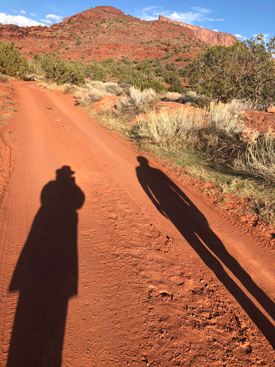
Social distancing in the desert. (Photo: courtesy of Terry Tempest Williams)
CURWOOD: [LAUGHS]
WILLIAMS: -- hoping to heaven that we had enough to cover it. And it was $1.50 an acre. That, these are our public lands; that's cheaper than a cup of coffee, certainly here in Cambridge. And we immediately formed the Tempest energy company, LLC. The BLM, because we said we would not develop these leases untel science could prove to us that the oil and gas was worth more above ground than below, they took that as an offense, even though many of those men -- and they were men, that I was sitting next to -- had no intention of developing those leases until the price of oil went up; nine months later they revoked our leases. Through the Freedom of Information Act we learned that no leases have been revoked since the 1920 Minerals Leasing Act but ours. We've appealed the decision. It's now before the Board of Land Appeals in the Department of Interior. It's now going on four years. And we're about to put some pressure on, with a very friendly administration right now, as you know.
CURWOOD: [LAUGHS] So, you repeat over and over again as a mantra, really, as a prayer, the phrase that "we are eroding and evolving all at once," throughout this book, "we are eroding and evolving." Why does that feel so vital, to have a mantra like that?
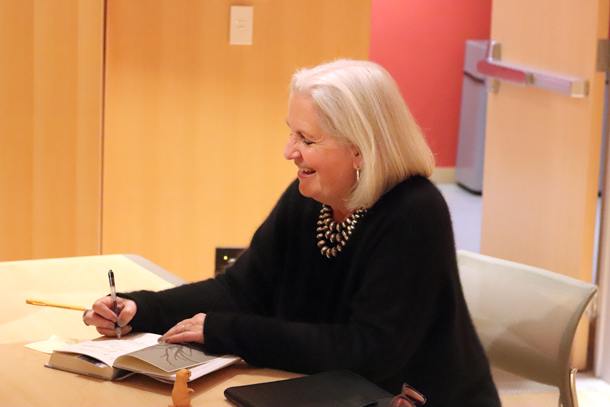
Terry signs copies of “Erosion” after the “Good Reads on Earth” event. (Photo: Jay Feinstein, Living on Earth)
WILLIAMS: Hope is not a word in my vocabulary, I have to tell you. Faith is. I remember my great grandmother, a Mormon, born in Mexico, said, "faith without works is dead." But in the middle of this erosion of democracy, of decency, of science, all the things that you and I care about, I think back to home. Castleton Tower, The Priest and Nuns, Round Mountain, Porcupine Rim, the Colorado River, Monument Valley, Grand Canyon, Bears Ears. There is beauty in erosion. And that has been evolving over time. So I think it takes us to our essence. It may take us to our knees; our consciousness is evolving. And I think it's not so much about hope as knowing where hope dwells. And I think for me, hope dwells in community. I don't know about you, but there are moments where I wake up and I think I don't know if I can get up today, you know? Despair is very real. But that is the limits of my own imagination. Imaginations shared create collaboration; in collaboration, we create community, and in community, anything is possible.
CURWOOD: So Terry Tempest Williams, we've been asking you a lot of questions tonight. But since you wrote in the preface of, of this book, that it is a book of questions as I recall, I'd like to ask you, what is your question, if you could pick one for this moment?

Terry Tempest Williams at home in Castle Valley. (Photo: courtesy of Terry Tempest Williams)
WILLIAMS: How do we find the strength to face our grief? How do we find the strength to bear our broken hearts, whether it's with what we're facing with a loss of species, with what we're facing with rising tides. We're going to be facing some very hard things in the future. And I, I hope that we have a consciousness that can rise to this moment. That's the question I have: how do we strengthen one another? How do we find the courage to act? How do we support one another? How do we find the strength to not look away? To stay steady? And here's, here's a story. One of the things that Jeff Moore said, Jeff Moore's the geologist that found the pulse with his graduate students. Five of them; they came to our house for a cup of tea. And as we sat there, he said, "Terry, there's something I want to ask you. We have found a piece of information and we don't know what to do with it. We do not have the language to articulate this to where we don't sound soft-headed." Here's what they found, if I understand it. Castleton Tower has gone through millions of years of fractures, shearing, ice, wind, water. There was another tower next to it, it is gone. It has just been whittled and whittled and whittled into this perfect point. What they have found, through algorithms and through their resonance studies, is that it has now achieved a steady state of stability. I mean as a writer, metaphorically that is so exquisite. So if we are in this process of eroding, can we, too, find this steady state of stability, calm, consciousness.
CURWOOD: Terry Tempest Williams is the author of "Erosion: Essays of Undoing"; "Refuge"; and numerous other books, and she's currently a Writer-in-Residence at the Harvard Divinity School. Terry, thank you so much for taking this time.
WILLIAMS: Thank you, Steve.
[AUDIENCE APPLAUSE]
Links
Outside | “This Rock Has a Voice And You Can Listen to It”
NYTimes op-ed by Terry Tempest Williams | “Keeping My Fossil Fuel in the Ground”
About Utah Diné Bikéyah and its advocacy for Bears Ears National Monument
A coalition of Bears Ears advocates is suing the federal government to restore the national monument
Living on Earth wants to hear from you!
Living on Earth
62 Calef Highway, Suite 212
Lee, NH 03861
Telephone: 617-287-4121
E-mail: comments@loe.org
Newsletter [Click here]
Donate to Living on Earth!
Living on Earth is an independent media program and relies entirely on contributions from listeners and institutions supporting public service. Please donate now to preserve an independent environmental voice.
NewsletterLiving on Earth offers a weekly delivery of the show's rundown to your mailbox. Sign up for our newsletter today!
 Sailors For The Sea: Be the change you want to sea.
Sailors For The Sea: Be the change you want to sea.
 The Grantham Foundation for the Protection of the Environment: Committed to protecting and improving the health of the global environment.
The Grantham Foundation for the Protection of the Environment: Committed to protecting and improving the health of the global environment.
 Contribute to Living on Earth and receive, as our gift to you, an archival print of one of Mark Seth Lender's extraordinary wildlife photographs. Follow the link to see Mark's current collection of photographs.
Contribute to Living on Earth and receive, as our gift to you, an archival print of one of Mark Seth Lender's extraordinary wildlife photographs. Follow the link to see Mark's current collection of photographs.
 Buy a signed copy of Mark Seth Lender's book Smeagull the Seagull & support Living on Earth
Buy a signed copy of Mark Seth Lender's book Smeagull the Seagull & support Living on Earth

